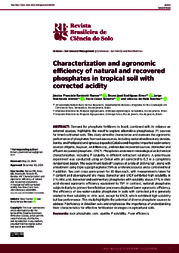Embrapa Agrobiologia
 Busca de publicações
Busca de publicações
Characterization and agronomic efficiency of natural and recovered phosphates in tropical soil with corrected acidity.
Resumo: Demand for phosphate fertilizers in Brazil, combined with its reliance on external sources, highlights the need to explore alternative phosphorous (P) sources for limed cultivated soils. This study aimed to characterize and evaluate the agronomic performance of phosphates from various sources, including national sedimentary (Arraias, Bonito, and Pratápolis) and igneous deposits (Catalão and Registro) imported sedimentary sources (Algeria, Bayovar, and Morocco), and residue-recovered sources (Bonechar and effluent recovered phosphate – ERCP). Phosphates underwent mineralogical and chemical characterization, including P solubility in different extractant solutions. A greenhouse experiment was conducted using an Oxisol with pH corrected to 6.3 in a completely randomized design. The experiment tested P sources at a rate of 160 mg kg-1, along with a treatment using triple superphosphate (TSP) as a reference source and a control without P addition. Two corn crops were grown for 45 days each, with measurements taken for P content and aboveground dry mass. Bonechar and ERCP exhibited high solubility in 2 % citric acid. Bonechar and sedimentary phosphates with solubility above 27 % in citric acid showed agronomic efficiency equivalent to TSP. In contrast, national phosphates subjected only to primary beneficiation processes displayed lower agronomic efficiency. The efficiency of low-water-soluble phosphates in soils with corrected pH is generally related to their solubility in citric acid, except for ERCP, which exhibited high solubility but low performance. This study highlights the potential of diverse phosphate sources to address P deficiency in Brazilian soils and emphasizes the importance of understanding their characteristics for effective fertilization strategies in agricultural soils.
Ano de publicação: 2025
Tipo de publicação: Artigo de periódico
Unidade: Embrapa Agrobiologia
Palavras-chave: Eficiência agronômica, Fertilizante Fosfatado, Fertilizers, Fosfato, Fósforo, Phosphates, Phosphorus fertilizers, Solo Tropical, Tropical soils

